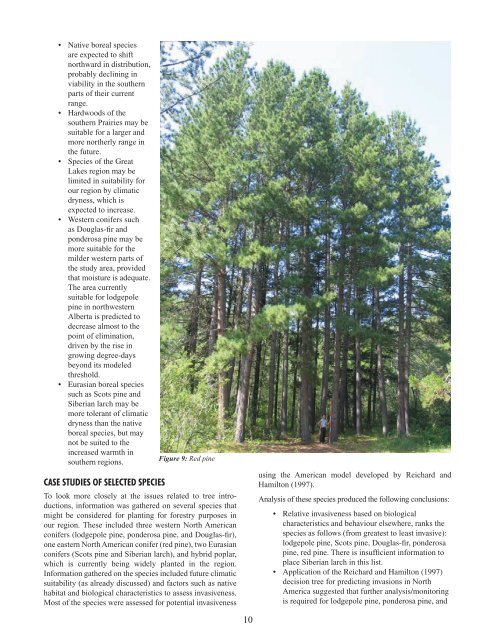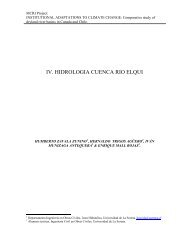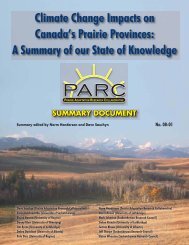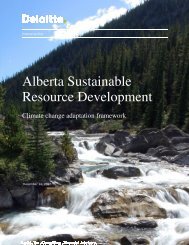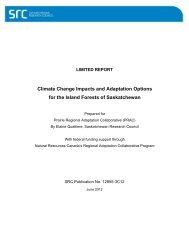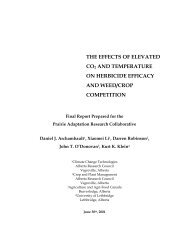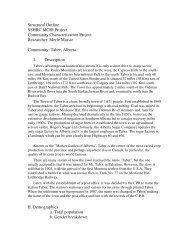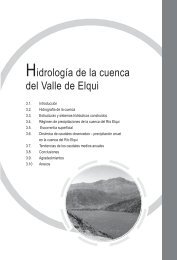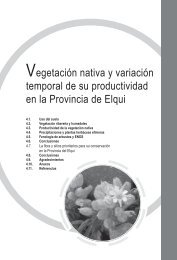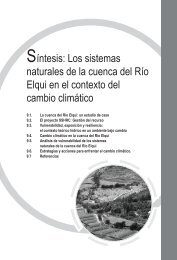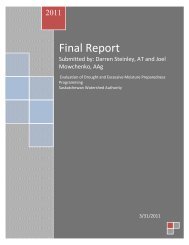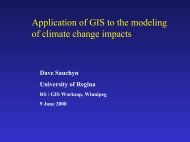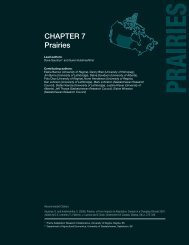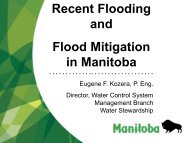Exotic Tree Species as an Adaptation Option to Climate Change in ...
Exotic Tree Species as an Adaptation Option to Climate Change in ...
Exotic Tree Species as an Adaptation Option to Climate Change in ...
Create successful ePaper yourself
Turn your PDF publications into a flip-book with our unique Google optimized e-Paper software.
• Native boreal species<br />
are expected <strong>to</strong> shift<br />
northward <strong>in</strong> distribution,<br />
probably decl<strong>in</strong><strong>in</strong>g <strong>in</strong><br />
viability <strong>in</strong> the southern<br />
parts of their current<br />
r<strong>an</strong>ge.<br />
• Hardwoods of the<br />
southern Prairies may be<br />
suitable for a larger <strong>an</strong>d<br />
more northerly r<strong>an</strong>ge <strong>in</strong><br />
the future.<br />
• <strong>Species</strong> of the Great<br />
Lakes region may be<br />
limited <strong>in</strong> suitability for<br />
our region by climatic<br />
dryness, which is<br />
expected <strong>to</strong> <strong>in</strong>cre<strong>as</strong>e.<br />
• Western conifers such<br />
<strong>as</strong> Dougl<strong>as</strong>-fir <strong>an</strong>d<br />
ponderosa p<strong>in</strong>e may be<br />
more suitable for the<br />
milder western parts of<br />
the study area, provided<br />
that moisture is adequate.<br />
The area currently<br />
suitable for lodgepole<br />
p<strong>in</strong>e <strong>in</strong> northwestern<br />
Alberta is predicted <strong>to</strong><br />
decre<strong>as</strong>e almost <strong>to</strong> the<br />
po<strong>in</strong>t of elim<strong>in</strong>ation,<br />
driven by the rise <strong>in</strong><br />
grow<strong>in</strong>g degree-days<br />
beyond its modeled<br />
threshold.<br />
• Eur<strong>as</strong>i<strong>an</strong> boreal species<br />
such <strong>as</strong> Scots p<strong>in</strong>e <strong>an</strong>d<br />
Siberi<strong>an</strong> larch may be<br />
more <strong>to</strong>ler<strong>an</strong>t of climatic<br />
dryness th<strong>an</strong> the native<br />
boreal species, but may<br />
not be suited <strong>to</strong> the<br />
<strong>in</strong>cre<strong>as</strong>ed warmth <strong>in</strong><br />
southern regions.<br />
Figure 9: Red p<strong>in</strong>e<br />
C<strong>as</strong>e Studies of Selected <strong>Species</strong><br />
To look more closely at the issues related <strong>to</strong> tree <strong>in</strong>troductions,<br />
<strong>in</strong>formation w<strong>as</strong> gathered on several species that<br />
might be considered for pl<strong>an</strong>t<strong>in</strong>g for forestry purposes <strong>in</strong><br />
our region. These <strong>in</strong>cluded three western North Americ<strong>an</strong><br />
conifers (lodge pole p<strong>in</strong>e, ponderosa p<strong>in</strong>e, <strong>an</strong>d Dougl<strong>as</strong>-fir),<br />
one e<strong>as</strong>tern North Americ<strong>an</strong> conifer (red p<strong>in</strong>e), two Eur<strong>as</strong>i<strong>an</strong><br />
conifers (Scots p<strong>in</strong>e <strong>an</strong>d Siberi<strong>an</strong> larch), <strong>an</strong>d hybrid poplar,<br />
which is currently be<strong>in</strong>g widely pl<strong>an</strong>ted <strong>in</strong> the region.<br />
Information gathered on the species <strong>in</strong>cluded future climatic<br />
suitability (<strong>as</strong> already discussed) <strong>an</strong>d fac<strong>to</strong>rs such <strong>as</strong> native<br />
habitat <strong>an</strong>d biological characteristics <strong>to</strong> <strong>as</strong>sess <strong>in</strong>v<strong>as</strong>iveness.<br />
Most of the species were <strong>as</strong>sessed for potential <strong>in</strong>v<strong>as</strong>iveness<br />
us<strong>in</strong>g the Americ<strong>an</strong> model developed by Reichard <strong>an</strong>d<br />
Hamil<strong>to</strong>n (1997).<br />
Analysis of these species produced the follow<strong>in</strong>g conclusions:<br />
• Relative <strong>in</strong>v<strong>as</strong>iveness b<strong>as</strong>ed on biological<br />
characteristics <strong>an</strong>d behaviour elsewhere, r<strong>an</strong>ks the<br />
species <strong>as</strong> follows (from greatest <strong>to</strong> le<strong>as</strong>t <strong>in</strong>v<strong>as</strong>ive):<br />
lodgepole p<strong>in</strong>e, Scots p<strong>in</strong>e, Dougl<strong>as</strong>-fir, ponderosa<br />
p<strong>in</strong>e, red p<strong>in</strong>e. There is <strong>in</strong>sufficient <strong>in</strong>formation <strong>to</strong><br />
place Siberi<strong>an</strong> larch <strong>in</strong> this list.<br />
• Application of the Reichard <strong>an</strong>d Hamil<strong>to</strong>n (1997)<br />
decision tree for predict<strong>in</strong>g <strong>in</strong>v<strong>as</strong>ions <strong>in</strong> North<br />
America suggested that further <strong>an</strong>alysis/moni<strong>to</strong>r<strong>in</strong>g<br />
is required for lodgepole p<strong>in</strong>e, ponderosa p<strong>in</strong>e, <strong>an</strong>d<br />
10


